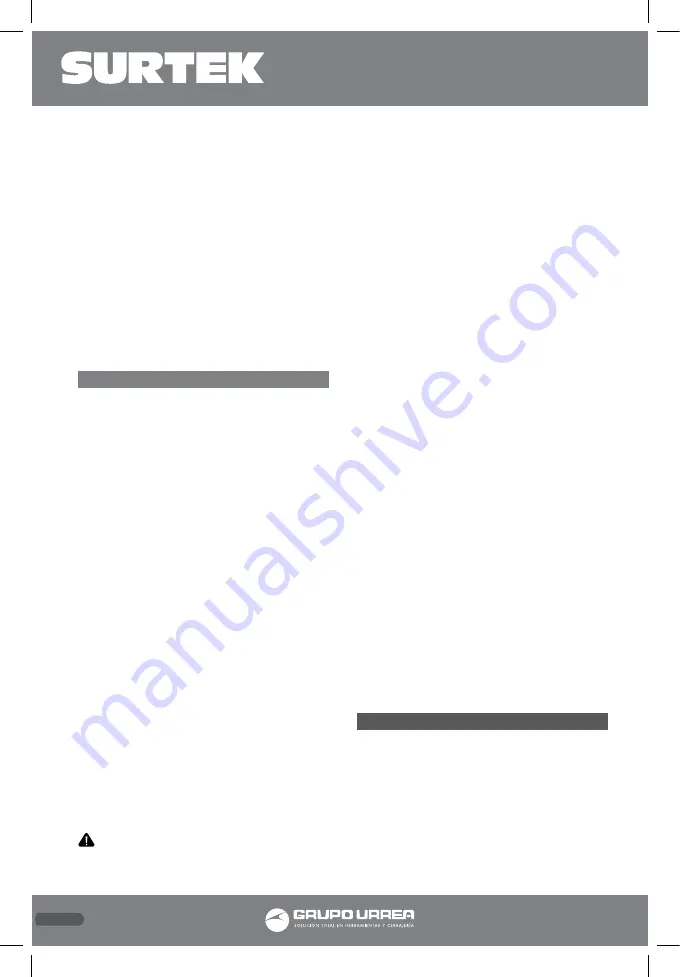
6
Many accidents are caused by poorly main-
tained tools. There is a risk of bursting if the
tool is damaged.
7. Use only accessories that are identified by
the manufacturer for the specific tool model.
Use of an accessory not intended for use with
the specific tool model, increases the risk of in-
jury to persons.
SERVICE
1. Tool service must be performed only by qual-
ified repair personnel.
2. When servicing a tool, use only identical re-
placement parts. Use only authorized parts.
3. Use only the lubricants supplied with the
tool or specified by the manufacturer.
OPERATION INSTRUCTIONS
PRIOR THE OPERATION
The tool is intended to be operated as a hand
held tool. It is always recommended that while
using the tool, operators stand on a solid floor,
in a secure position with a firm grip and foot-
ing.
Use a clean lubricated air supply that will give
a measured air pressure at the tool of 90 PSI
when the tool is running with the lever fully
depressed. Do not connect the tool to the air-
line system without an easily accessible air shut
off valve. It is strongly recommended that an
air filter, regulator and lubricator (FRL) be used
as this will supply clean, lubricated air at the
correct pressure to the tool. In any case appro-
priate air pressure regulators shall be used at
all times while operating this tool where the
supply pressure exceeds the marked maximum
of the tool.
Details of such equipment can be obtained for
your tool distributor. If such equipment is not
used, the tool should be manually lubricated.
To manually lubricate the tool, disconnect the
airline and put 2 to 3 drops of suitable pneu-
matic motor lubricating oil into the hose end
(inlet) of the tool. Reconnect tool to the air
supply and run tool slowly for a few seconds to
allow air to circulate the oil. If the tool is used
frequently, lubricate it on a daily basis or lubri-
cate it if the tool starts to slow or lose power.
IMPORTANT:
Design the air supply line to
ensure maximum operating pressure in the air
inlet of the tool. Condensation drain valve on
bottom outlets of the pipe, air filter and com-
pressor tank daily.
Install a safety coupling (sliding valve) and use
a hose and couplings restraint in any hose cou-
pling without internal damper to prevent the
hoses whiplash in the event that fails or is dis-
connected.
It is recommended that the air pressure at the
tool be 90 PSI while the tool is running so the
maximum RPM is not exceeded. The tool can
be run at lower pressures but should never be
run higher than 90 PSI. If run at lower pressure
the performance of the tool is reduced.
CONNECTION TO AN AIR SOURCE
1. Never connect to an air source that is ca-
pable of exceeding the pressure specified by
the supplier. Over pressurizing the tool may
cause bursting, abnormal operation, break-
age of the tool or serious injury to persons.
Use only clean, dry, regulated compressed air
at the rated pressure or within the rated pres-
sure range as marked on the tool. Always ver-
ify prior to using the tool that the air source
has been adjusted to the rated air pressure or
within the rated air-pressure range.
2. Never use oxygen, carbon dioxide, combus-
tible gases or any bottled gas as an air source
for the tool. Such gases are capable of explo-
sion and serious injury to persons.
3. Incorporate a filter, regulator with pressure
gauge, oiler, in-line shutoff valve, and quick
coupler for best service, as shown on next
figure. An in-line shutoff ball valve is an im-
portant safety device because it controls the
air supply even if the air hose is ruptured. The
shutoff valve should be a ball valve because it
can be closed quickly.
MAINTENANCE
Maintenance frequency is shown in the illus-
tration below.
PARTS & MAINTENANCE
Tool repair and maintenance should only be
carried out by an authorized Service Center.
When the life of the tool has expired, it is rec-
ommended that the tool be disassembled, de
greased and parts be separated by material so
that they can be recycled.
MN638A-MN612A manual.indd 6
28/05/15 10:58


























